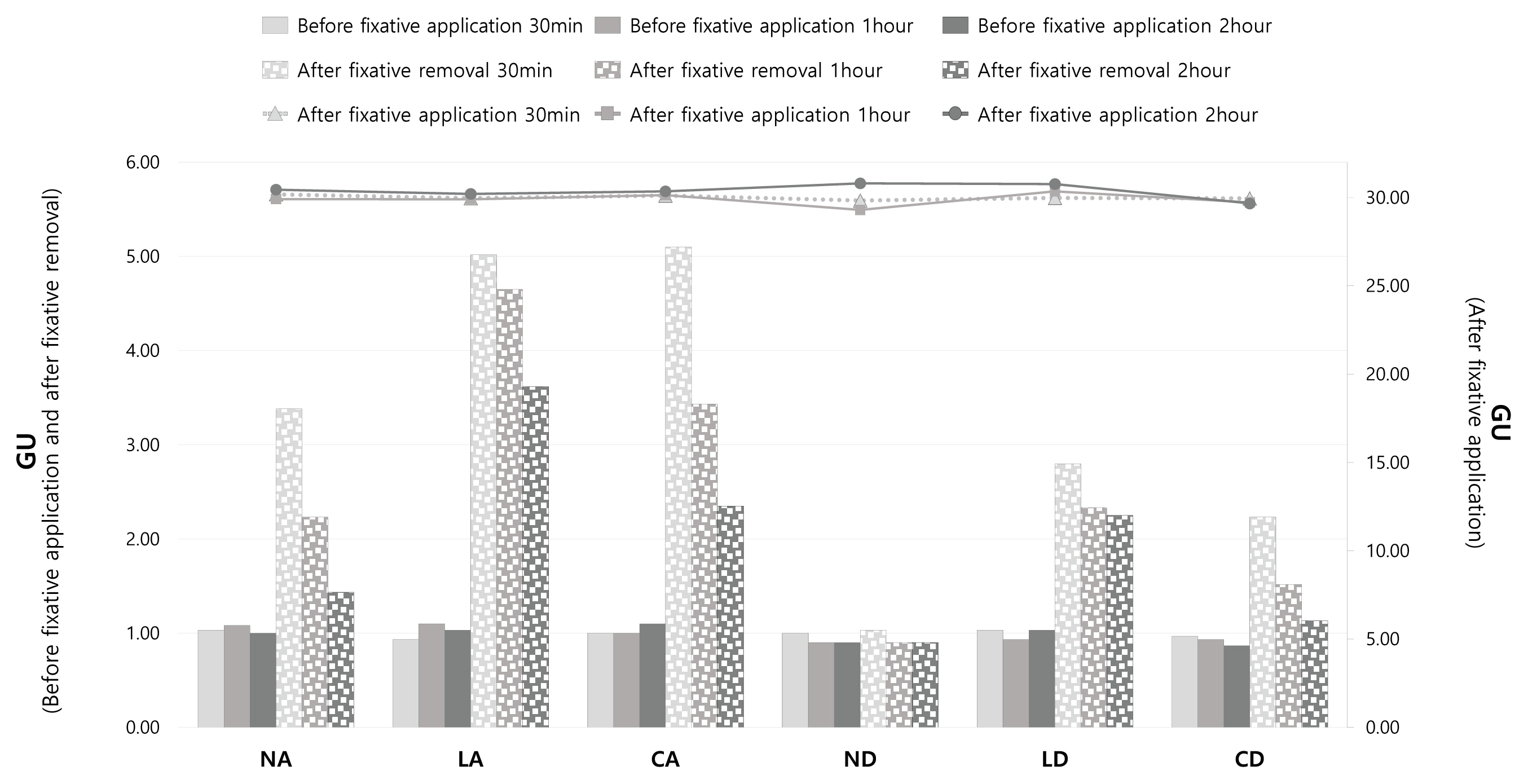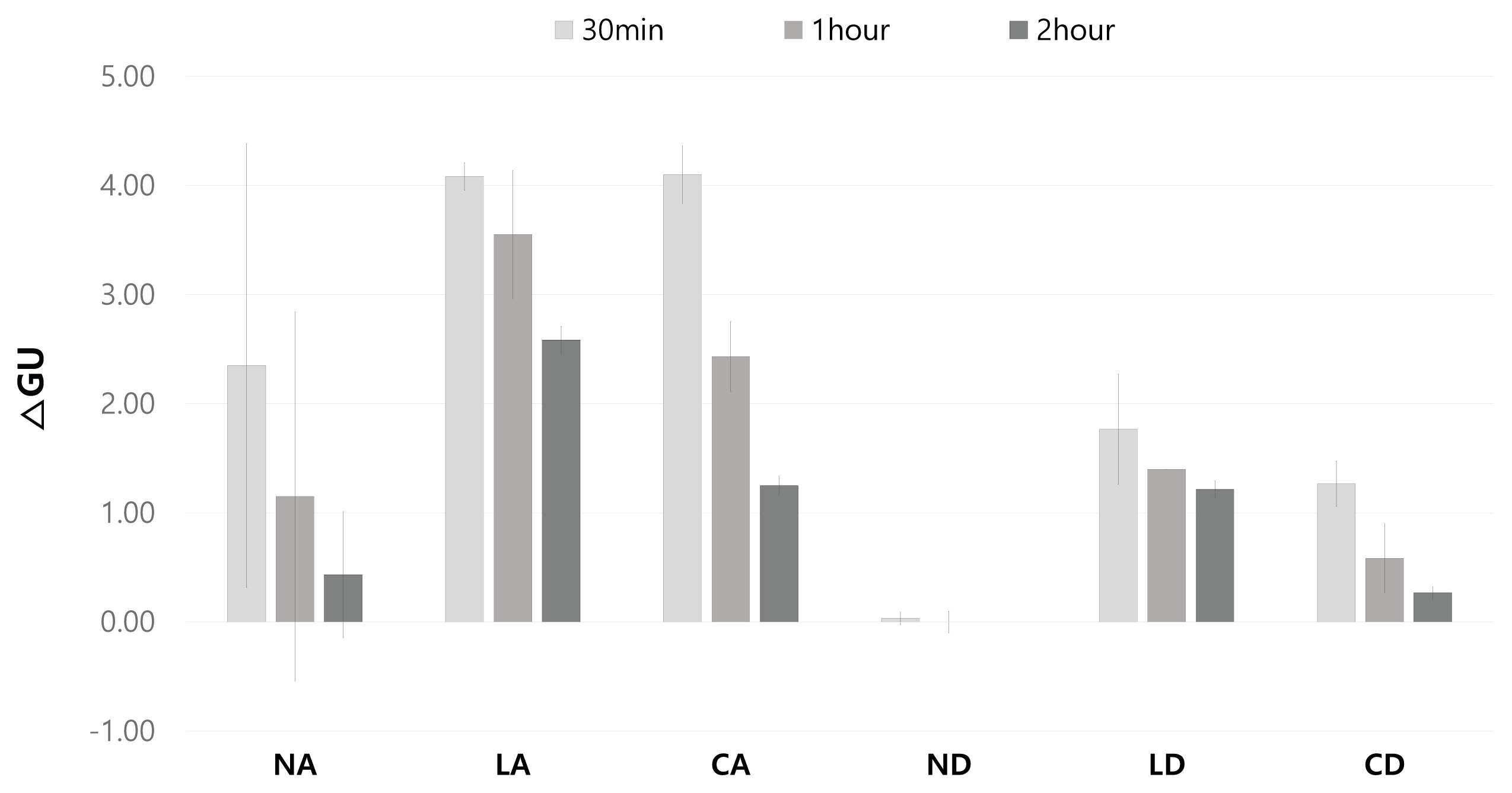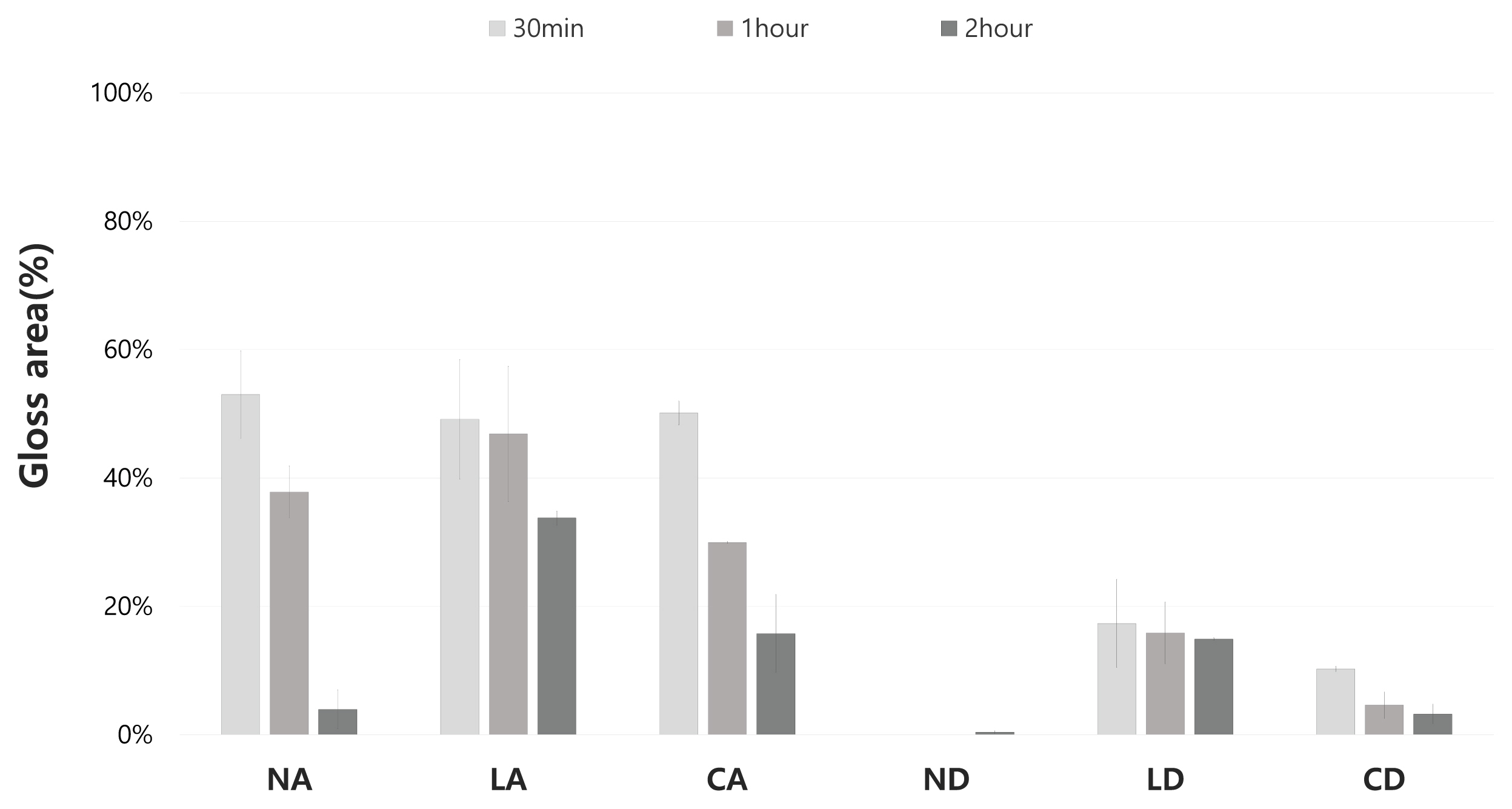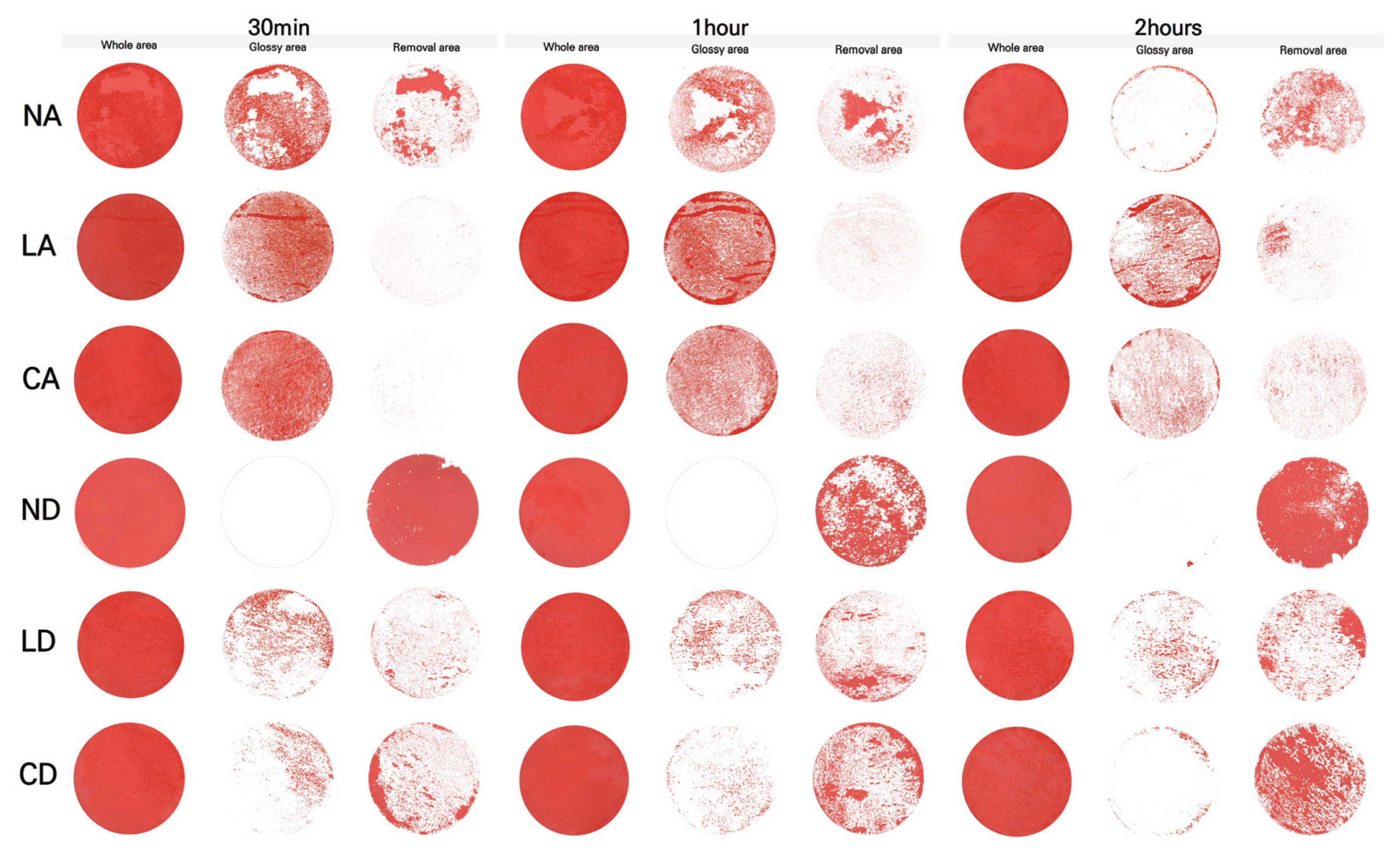Study on the Gel Cleaning System for Removal of Poly(Vinyl Acetate) Fixative of the Mural Paintings of the Payathonzu temple in Bagan, Myanmar (II) : Focusing on Applicability of Gel Cleaners
Article information
Abstract
In this study, a gel cleaning experiment was conducted to stably remove the fixative (PVAc) used in the past conservation treatment of the mural painting of the Payathonzu temple. This study prepared mock-up samples reflecting the material properties and conservation status of the mural painting of the Payathonzu temple, and conducted an experiment about the applicability of 6 types of gel cleaners to discern potential changes when they are applied to the actual mural painting and to review their stability. This study found that the gel cleaner mixed with dimethyl carbonate had a superior removal effect to the gel cleaner mixed with acetone. Furthermore, for the same solvent, the gelling agent showed the removal effect in the order of Nevek®> Carbopol®980 > Laponite®RD. Upon examining change patterns after applying the cleaners, this study found that the cleaners with a superior removal power had a similar trend to that in removal effect evaluation in a previous study. In actually applying to the mural painting, however, the cleaners showed some inconsistent results with those in removal power evaluation, and it was confirmed that these results were attributable to the properties of the cleaners interacting with the properties of the mural painting and the extent of penetration of the fixative. It was also found that not only the conditions of the cleaners but also the material and painting technique characteristics of the mural could have a huge effect during the removal of the fixative. What is most important in removing the fixative applied to the mural painting of the Payathonzu temple is to ensure the stability of its painting layer by using a cleaning method that is controllable by the person treating the painting, and then, the properties that can help to effectively remove the fixative are required. At a time whenthere are few related studies in Korea, this study and its method may serve as a reference for future research on the removal of the fixative applied to a mural.
1. INTRODUCTION
The aesthetics of the mural painting of the Payathonzu Temple is undermined as the fixative applied in the past causes the cracking and peeling of its painting layer as well as excessive glossiness (Korea Culture Heritage Foundation et al., 2019). To conserve the painting layer of the mural painting of the Payathonzu Temple, it is required to stabilize its painting layer previously treated with the fixative in the past. For this purpose, this study examined the gel cleaning system for removing the polyvinyl acetate fixative.
In previous Part 1 of the study, we identified the properties of the gel cleaner prepared by using the cleaning materials studied on the mural painting of a temple in Bagan. Based on these findings, this study evaluated the removal power of the polyvinyl acetate fixative treated on the mural painting of the Payathonzu Temple. Six types of gel cleaners were prepared by mixing 3 gelling agents (Nevek®, Laponite®RD, and Carbopol®980) and 2 solvents (acetone and dimethyl carbonate). This study was able to identify the factors that most contributed to the removal of the fixative based on the solvent’s conditions and the gelling agent included in the cleaner. The conditions of the gel cleaner identified in the experiment, however, may work differently depending on the material and painting technique of the mural to which it is actually applied.
Cleaning is a complex process in which the method varies depending on the material to be treated or the substance to be removed, and as it is an irreversible process that cannot be undone after treatment, much care must be taken. In particular, cleaning of mural painting is an extremely difficult task that requires direct intervention on the surface of the sensitive painting layer (Lee et al., 2015). In the case of easel painting, the surface is coated with varnish etc., but the surface particulate and porosity of mural paintings may appear differently depending on the material or technique. The characteristics of these murals have a significant impact on the cleaning process, and work should be done with this in mind. In the case of fresco, the durability of the painting layer is relatively higher compared to dry technique murals that use medium (or vehicle).
For this reason, contaminants can be removed physically using a sponge etc., but if physical force is applied to the painting layer with reduced physical properties, the pigment may peel off and the painted surface may be damaged (Baglioni et al., 2014). Depending on the characteristics of the object, stable conditions can become high-risk conditions, so understanding the object before processing is essential and testing must be done first.
In this Part 2 of the study, mock-up samples reflecting the material and painting technique characteristics of the mural of the Payathonzu temple were prepared, and an experiment for the applicability of 6 types of gel cleaners was conducted to determine the removal effect and stability of the gel cleaners.
2. MATERIALS AND METHODS
2.1. Mock-up samples of mural painting
The mock-up samples were prepared to reflect the material properties and status of the wall and the mural’s painting layer identified in a study on the painting techniques of the mural of the Payathonzu temple (Korea Culture Heritage Foundation et al., 2019). The mock-up samples were prepared in 4 layers: wall layer, base layer, painting layer, and fixing layer (Table 1, Figure 1, 2). For the wall layer, they were mixed with the ratio of lime (1) : sand (4), For sand, the distribution of medium or bigger sand (48%), fine or smaller sand (37%), and silt or smaller sand (15%) was used based on the results of the particle size analysis of the finishing layer of the mural of the Payathonzu temple.
The ground layer was mixed with gypsum and distilled water in the 1:1 weight ratio, and then applied with the brush after the wall was completely dry. It was applied once, considering the thickness of the base applied actually to the mural.
Painting was conducted after drying at room temperature until no more gypsum came out. Painting was applied once by using the mixture of pigment (cinnabar) and neem resin (5% in water).
Polyvinyl acetate bead resin (10% dissolved in toluene) was used for the fixative layer. It was applied about 6 times with the brush based on the level of excessive glossiness constantly exhibited on the surface of the samples to be prepared in the same conditions as those of the surface of the mural of the Payathonzu temple. The mural is made of porous material, which penetrates inside the layer formed under the painting layer during the fixation process, and the depth of penetration is difficult to clearly understand. However, according to existing research results, when a transparent thick film is formed on the surface of a mural painting layer by applying a PVAc fixative agent, it is reported to be a phenomenon in which the agent strongly penetrates up to about 45 μm from the surface (Lee, 2013). In another example, it has been reported that microstructure of fixative layer is observed even when the surface gloss of the fixative layer is removed (Yu and Lee, 2020). Therefore, in this experiment, we attempted to reproduce the glossy state appearing on the surface of the mural of phayatonzu temple rather than the exact thickness of fixative layer.
The mock-up samples were prepared in Ø 60 × 15 mm, and a total of 54 samples were made, 3 each per cleaning condition.
2.2. Gel cleaners
The same gel cleaners used in the previous Part 1 of the study were used in this study (Yu et al., 2021). 6 types of gel cleaners (NA, LA, CA, ND, LD, CD) were prepared by mixing 3 gelling agents (N: Nevek®, L: Laponite®RD, and C: Carbopol®980) and 2 organic solvents (A: Acetone, and D: Dimethyl carbonate) (Table 2, Figure 3).
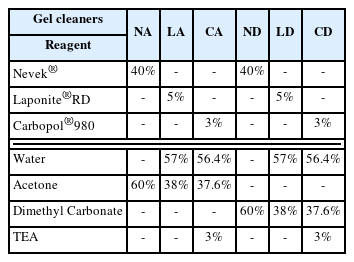
Recipe of gel cleaners (Yu et al., 2021)

Manufactured gel cleaners (Yu et al., 2021).
2.3. Evaluation methods
By applying the gel cleaners to the mock-up samples that reflect the material properties and status of the mural painting of the Payathonzu temple, this study attempted to identify potential changes on the surface of the actual mural based on the appearance of the mock-up samples.
The gel cleaners were applied in a constant amount and volume under all conditions. It was applied after placing rayon paper (TNT55, CTS, ITA) on the surface of the mock-up samples with the fixative applied to reduce damage to the painting layer by preventing the adhesion of the partially solubilized fixative to the samples.
To evaluate the gel cleaners’ applicability, this study conducted surface observation, chromaticity, and glossiness measurement on the mock-up samples before and after the gel cleaners were applied. The appearance resulting from different types of gel cleaners and application times was compared and evaluated for color changes, glossiness, and the removal status.
2.3.1. Surface observation
To observe the surface, a digital camera (G15, Canon, JPN) was used to check the overall appearance, and a scanner (MF236N, Canon, JPN) was used for observation under a constant source of light. The stereo microscope (SMZ-800N, Nikon, JPN) was used to identify the detailed status of the surface.
Photoshop (CC, Adobe, USA) was use to quantitatively compare the status of the surface after removal. The ratio of the glossy area with the residual fixative and the ratio of the removed area were identified. The status of the surface after removing the fixative was divided into 3 categories: the residual coat of the synthetic resin fixative (gloss), no remaining coat but a stain from the residual fixative (stain), and the fixative removed (removed).
Based on the scanned images, the ratio of pixels depending on the color distribution of the status of the surface was calculated and compared as in the equation provided below. By selecting colors representative of the status based on RGB values, this study divided the color distribution into similar color ranges (Figure 4).

Process using Adobe Photoshop’s color range function (A: Measurement of removal area of fixative, B: Result of removal area of fixative).
W0 : Total number of pixels in mock-up sample image
W1 : Number of pixels in surface state (glossy, stain, removed) (pixel)
2.3.2. Chromaticity
Chromaticity was measured to determine changes in chromaticity on the surface of the samples after removing the synthetic resin fixative by type of gel cleaner and application time. Furthermore, chromaticity was measured at the same location of the samples before and after applying the synthetic resin fixative and after removing the fixative. Four different locations of the same sample were measured, and the average value was calculated by measuring each gel cleaner 3 times. As a measurement instrument, the colorimeter (CR-400, Konica Minolta, JPN) was used under the light source of D65, and the average value was calculated after measuring the same location 3 times.
2.3.3. Glossiness
The glossiness value was measured at the same location of the samples before and after applying the synthetic resin fixative and after removing the fixative to compare the extent of changes in glossiness (ΔG). Measurement was conducted using the glossmeter (AG-4563, BYK, DEU) under the conditions of the measurement angle of 60° and the measurement area of 9 × 15 mm. The same location was measured 2 times, and the average value was calculated. Each gel cleaner was measured 3 times, and the average value was calculated. As glossiness indicates the glossiness value of the measured area itself, there may be some limitation due to the difference in glossiness distribution. Hence, this study used the glossiness value to obtain quantitative information on the glossiness ratio. Changes in glossiness were compared and evaluated by calculating the difference between glossiness values before applying the synthetic resin fixative and after removing the fixative.
3. RESULT AND DISCUSSION
3.1. Microscopy
The microscopic observation of changes in the surface of the painting layer of the mock-up samples confirmed the removal effect of the gel cleaners under the conditions of using dimethyl carbonate as the solvent and Nevek as the gelling agent or under the conditions of applying the cleaners for 2 hours (Figure 5).

Microscopy image of painting layer according to gel cleaning (A: Original image, B: Black and white image correction).
The residual traces of the synthetic resin fixative, however, were observed from the surface of most samples after removing the fixative. Although there were some differences depending on the conditions of the gel cleaner, glossiness or stain was observed due to the distribution of the fixative forming a coat. A comparison based on the presence and distribution of glossiness and stain showed that the removal effect of the conditions of ND was superior to those of other gel cleaners. Under the conditions of ND, glossiness on the surface was not confirmed regardless of the application time, and the status of the surface is considered uniform and similar to that of the sample before applying the synthetic resin fixative, especially when applied for 30 minutes.
During the evaluation of the applicability of the gel cleaners, this study identified the conditions in which their removal effect tended to be different from the results of their removal power evaluation. To begin with, under the conditions of ND, an increase in the removal effect was not proportional to the passage of time. This seems to be because of the re-penetration of the fixative due to the over-applied gel cleaner. Furthermore, the conditions of NA, when applied for 2 hours, showed a higher effect of removing the synthetic resin fixative compared to the conditions of LD. The reason seems to be because a different removal effect was manifested depending on the penetration status of the fixative applied to the porous surface under the conditions of NA.
3.2. Chromaticity
Comparing the color difference (ΔE) of the samples after applying the synthetic resin fixative and after removing the fixative relative to those before applying the fixative, the samples after applying the fixative showed the average change of 11.04 (±0.69) in the color difference value compared to those before applying the fixative. After removing the fixative, the samples showed the minimum of 2.32 (±0.36) and the maximum of 8.72 (±1.64) depending on the gel cleaner and application time. Compared to the samples before applying the synthetic resin fixative, the brightness value of the samples after applying and removing the fixative changed to (−), and their saturation value changed to (+).
When the color difference of the samples after removing the synthetic resin fixative was analyzed relative to the samples before applying the fixative, the color difference for the gel cleaners was found in the order of ND < CD < NA < LD < CA < LA regardless of their application time (Figure 6).
A lower color difference value means that the color of the samples after removing the synthetic resin fixative is more similar to that of the samples before applying the fixative. However, the color difference value of all the gel cleaners except for ND was measured in the range of 3–8. In this range, the difference was recognizable to the naked eye. In particular, the cleaners with the color difference value of ≥6 indicated a large difference compared to the color of the samples before the synthetic resin fixative was applied. These results are considered attributable to the high ratio of the synthetic resin fixative forming a coat on the surface even after removal. The gel cleaners with the range of ≥3 to <6 seems to have these values because the penetrated fixative was not removed, although the ratio of the synthetic resin fixative forming a coat was relatively lower.
A comparison of the color difference depending on the application time of the gel cleaners confirmed that the color difference value for the cleaners, except for ND, tended to decrease along with the increasing application time. The color difference value of ND increased by about 0.1 over time, which is considered to be due to the difference in the time it took for the removal power of ND to emerge compared to other gel cleaners. The results of the gel cleaner removal ratio evaluation show that ND has a similar removal ratio for 30 minutes to the ratio for 1 and 2 hours. Therefore, the increase, albeit slight, in the color difference value in ND seems to be come from the re-penetration of the fixative as the gel cleaner was continuously applied to the surface where the synthetic resin fixative has dissolved.
The overall trend of the color difference confirmed that the difference varied depending on the solvent and gelling agent mixed in the gel cleaner. For the same gelling agent, dimethyl carbonate had a lower color difference than acetone, while for the same solvent, the lower color difference value was measured in the order of Laponite®RD > Carbopol®980 > Nevek®. It is found to be a similar trend with the gel cleaners which showed a superior removal power in their removal ratio evaluation.
However, NA and LD were confirmed to have results opposite to those of their gel cleaner removal ratio evaluation. This seems to be because NA had a lower removal power for the synthetic resin fixative compared to LD but had a less distribution of the fixative forming a coat on the surface. NA, however, had a large standard deviation in the value, and the extent of removal was not uniform. Accordingly, the reliability of the value is considered low. Hence, even though NA had a lower color difference value than LD, it has some limitation to be considered a gel cleaner with a superior removal effect.
3.3. Glossiness
After measuring the glossiness (GU) of the samples before and after applying the synthetic resin fixative and after removing the fixative, this study found that the average glossiness value before applying the fixative was in the range of 1.0, while the average glossiness value after applying the fixative was in the range of 30.0 (Figure 7). The glossiness value after removing the synthetic resin fixative varied but ranged from 1 to 5.
After measuring changes in glossiness (ΔGU) before applying the synthetic resin fixative and after removing the fixative (Figure 8), this study confirmed that overall, it was lower in the conditions in which dimethyl carbonate was applied than the conditions in which acetone was applied, and by gelling agent, it was in the order of Laponite®RD > Carbopol®980 > Nevek®.
For NA, the removal effect tended to differ depending on the gel cleaner’s application time. From the above evaluation results, it was confirmed that NA was less effective as a gel cleaner than LD regardless of the application time. Meanwhile, changes in glossiness were lower for NA than LD under the 1-hour and 2-hour application conditions. It seems to be a result of the difference between visibility and changes in glossiness (ΔGU). A previous study reported that visibility and glossiness changes, which indicate the extent of damage to the surface perceived by humans, do not always correspond to each other (Jung and Weon, 2013). Changes in glossiness for NA at 1-hour application are considered to have low reliability, because it had a big difference in standard deviation and was also different from the trend from surface observation. As glossiness represents in numbers how glossy an object’s surface is depending on the ratio and directional distribution of reflection light, its results may appear differently depending on the measurement conditions and glossiness distribution. Therefore, the glossiness value should be determined by comparing with the status of glossiness and the glossiness ratio from surface observation.
3.4. Gloss and removal area
After applying the gel cleaners, this study used the color distribution and compared the area where the synthetic resin fixative was removed and the area where it remained as a coat and showed glossiness.
After identifying the color distribution showing glossiness (Figure 9), this study found that ND was the gel cleaner with the smallest ratio of glossiness. Overall, for the gel cleaner mixed with dimethyl carbonate, the glossiness ratio was found to be twice as low as the gel cleaner mixed with acetone, and it was in the order of Laponite®RD > Carbopol®980 > Nevek®.
With acetone, the trend was different from the other gel cleaners as it was measured in the order of Nevek®> Carbopol®980 > Laponite®RD at 30 minutes of application. These results are attributable to an uneven distribution of the fixative forming a coat under the 30min application condition of NA. When applied for 2 hours, NA had a lower glossiness ratio than LD, which is consistent with the trend from the results of color change evaluation and glossiness status evaluation.
After measuring the removal ratio (Figure 10), this study found that dimethyl carbonate was overall superior to acetone in the conditions of the solvents and Nevek® was more effective than Carbopol®980 and Laponite®RD in the conditions of the gelling agents. An increased removal ratio over time was found different across different gel cleaners. It confirms noticeable similarity in the results and trends of the aforementioned evaluations.
Considering these trends together, a solvent with relatively high solubility and a gelling agent with low viscosity are considered more effective in removing the fixative. A solvent with high solubility can remove a larger amount of the fixative during the same period of time than a solvent with relatively lower solubility, and the lower viscosity of the gelling agent is considered to have superior removal properties due to a higher ratio of the area coming in contact with the target surface. After observing the surface status of the mock-up samples after applying the gel cleaner (Figure 11), however, this study found that it was somewhat not suitable as a cleaner due to the residual fixative or uneven removal, even though it had effective removal properties. More specifically, Nevek® was found highly variable in its removal effect depending on the mixed solvent and the application time. It was found that the cleaner mixed with acetone did not express sufficient removal within the application time, and the fixative peeled off as a film during the process of solubilizing the fixative. The gel cleaner mixed with dimethyl carbonate was overapplied, and the fixative re-penetrated. It suggests that the removal power of the cleaners does not completely match their actual removal effect when applied to the actual mural, and these results were attributable to the properties of the cleaners interacting with the properties of the mural painting and the extent of penetration of the fixative.
Since a mural painting has a porous structure in which the fixative can penetrate up to 2–3 mm during fixative treatment (Mora et al., 1984), the viscosity of a gelling agent and the concentration of a solvent may have a great effect on the dissolution of the fixative in applying a gel cleaner to remove the fixative. In particular, the mural painting of the Payathonzu temple consists of a high content of sand, which creates a lot of air gaps, and as it is made by the dry technique, it is likely to increase the risk of easily breaking down the bonds between pigments.
To remove the fixative applied to the mural painting of the Payathonzu temple, it is therefore necessary to first identify the solvent and gelling agent conditions considering the stability of the painting layer and find out the application time conditions that can show a great removal power. Moreover, as the extent of penetration of the fixative and the status of the painting layer cannot be predicted in actual murals, it would be needed to carefully verify them under various conditions for practical treatment.
4. CONCLUSION
This study examined the applicability of a gel cleaning system to effectively remove an excessively applied poly (vinyl acetate) fixative from the painting layer of the mural painting of the Payathonzu temple while ensuring the stability of the painting layer. The following conclusions were obtained through experiment about the applicability of six types gel cleaners (mixing three types of gelling agents and two types of solvents) on mock-up samples.
In previous Part 1 of the study (Yu et al., 2020), the results of the evaluation of the removal power of the gel cleaners showed that the removal ratio of the cleaner mixed with dimethyl carbonate was higher than that mixed with acetone, and the removal effect of the gelling agents was in the order of Nevek® > Carbopol®980 > Laponite®RD when the same solvent was used. The removal ratio increased as the application time of the gel cleaner increased.
After comprehensively investigating the removal effect in terms of color changes, glossiness changes, and removal status for the applicability of the gel cleaners to the mock-up samples in the conditions similar to those of the mural painting of the Payathonzu temple, this study found that the gel cleaner mixed with dimethyl carbonate had a superior removal effect to the gel cleaner mixed with acetone. Furthermore, for the same solvent, the gelling agent showed the removal effect in the order of Nevek® > Carbopol®980 > Laponite®RD. In the condition of mixing Carbopol®980 and dimethyl carbonate and the condition of mixing Laponite®RD and dimethyl carbonate, the removal effect increased as the application time increased, but in the condition of mixing Nevek® and dimethyl carbonate, the removal effect was achieved in 30 minutes was the highest.
This study found that the cleaning effect of a gel cleaner was influenced by the solubility and volatility of the solvent to the fixative and the solvent release properties of the gelling agent. Even if a gel cleaner had a superior removal power, its removal effect may vary depending on the application target and time.
The gel cleaning system studied in this experiment has a removal effect on poly(vinyl acetate) fixative, and enabled selective cleaning by selectively applying the conditions that might control the cleaning action while reducing excessive solvent emissions.




